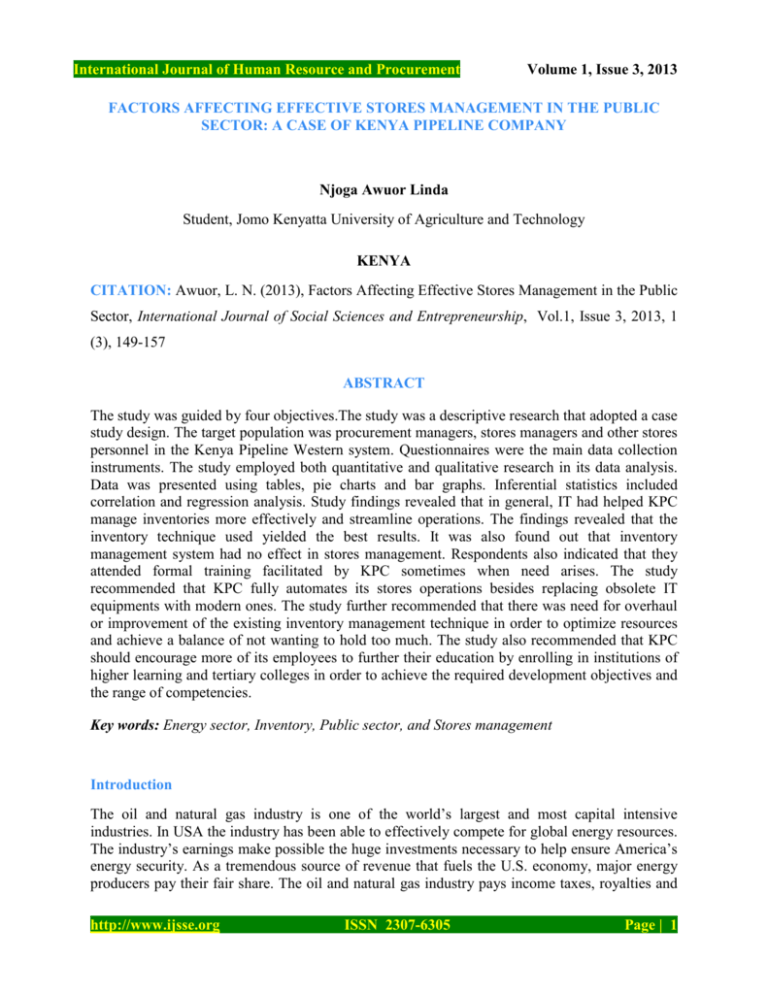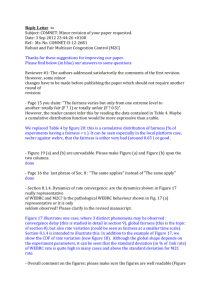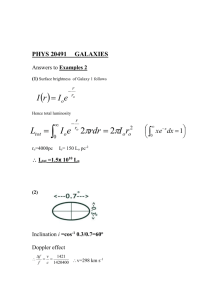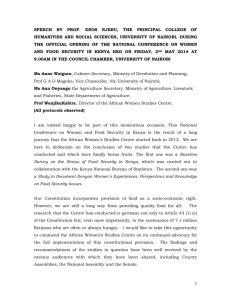Full Text PDF Format - IJSSE - International Journal of Social
advertisement

International Journal of Human Resource and Procurement Volume 1, Issue 3, 2013 FACTORS AFFECTING EFFECTIVE STORES MANAGEMENT IN THE PUBLIC SECTOR: A CASE OF KENYA PIPELINE COMPANY Njoga Awuor Linda Student, Jomo Kenyatta University of Agriculture and Technology KENYA CITATION: Awuor, L. N. (2013), Factors Affecting Effective Stores Management in the Public Sector, International Journal of Social Sciences and Entrepreneurship, Vol.1, Issue 3, 2013, 1 (3), 149-157 ABSTRACT The study was guided by four objectives.The study was a descriptive research that adopted a case study design. The target population was procurement managers, stores managers and other stores personnel in the Kenya Pipeline Western system. Questionnaires were the main data collection instruments. The study employed both quantitative and qualitative research in its data analysis. Data was presented using tables, pie charts and bar graphs. Inferential statistics included correlation and regression analysis. Study findings revealed that in general, IT had helped KPC manage inventories more effectively and streamline operations. The findings revealed that the inventory technique used yielded the best results. It was also found out that inventory management system had no effect in stores management. Respondents also indicated that they attended formal training facilitated by KPC sometimes when need arises. The study recommended that KPC fully automates its stores operations besides replacing obsolete IT equipments with modern ones. The study further recommended that there was need for overhaul or improvement of the existing inventory management technique in order to optimize resources and achieve a balance of not wanting to hold too much. The study also recommended that KPC should encourage more of its employees to further their education by enrolling in institutions of higher learning and tertiary colleges in order to achieve the required development objectives and the range of competencies. Key words: Energy sector, Inventory, Public sector, and Stores management Introduction The oil and natural gas industry is one of the world’s largest and most capital intensive industries. In USA the industry has been able to effectively compete for global energy resources. The industry’s earnings make possible the huge investments necessary to help ensure America’s energy security. As a tremendous source of revenue that fuels the U.S. economy, major energy producers pay their fair share. The oil and natural gas industry pays income taxes, royalties and http://www.ijsse.org ISSN 2307-6305 Page | 1 other fees totaling nearly $86 million every day. The industry also pays the federal government significant rents, royalties and lease payments for production—totaling more than $110 billion since 2000 U.S. based oil and gas companies have structured their operations and invested substantial capital where the resource is found rather than where the best tax regime is located. As a result, U.S. based oil and gas companies’ overseas income is often subject to very high effective tax rates (Spengler, 2010) Petroleum is the most important source of commercial energy. Petroleum fuels are imported in form of crude oil for domestic processing and also as refined products, and mainly used in the transport, commercial and industrial sectors (Kenya Pipeline Company Ltd, 2006b). Fluctuations in international prices directly affect domestic prices. For instance, the international price of Murban crude oil rose by 46% from US$ 62.05 per barrel in December 2008 to US$ 90.60 per barrel in December 2009 and about US$140 per barrel in August 2010, before plummeting to less than US$ 50 by March 2011. Total quantities of petroleum imports registered a growth of 16.4% to stand at 3,691.8 thousand tonnes in 2010. The total import bill of petroleum products rose by 7.1% in 2010 compared to 8.9% in 2009. Total domestic demand for petroleum products also rose by 2.8% from 3,131.5 thousandtonnes in 2010 to 3,218.3 thousand tonnes in 2011. Trends in the sale or consumption of petroleum fuels indicate that retail pump outlets and road transport constitute the single largest consumer of petroleum fuels followed by aviation and power generation in Kenya (RoK, 2006) Statement of the Problem From the detailed financial statements of the Kenya Pipeline Company, net profit after tax increased by 61% from Kshs. 2.8 billion in 2010 to Kshs. 4.5 billion in 2011, attributable to increased turnover as a resultof tariff adjustment, the favourable exchange rate on the US dollardenominated throughput and prudent management of operatingcosts. The net operating profit margin before tax increased to 47%up from 31% in the previous year (KPC, 2011). From the foregoing, it is evident that KPC contributes a significant proportion to Kenya’s GDP. Statistics available indicates that crisis related to stores management hinders effective management of stores in KPC.For instance, Triton Oil scandal of 2009 which involved the unauthorized releasing of oil by the Kenya Pipeline Company (KPC)in December 2008 when Triton Oil Company was allowed by KPC to withdraw the oil amounting to Kshs 7.6 billion which indicates that there was inefficiency in stores management (Petroleum Insight, 2011). Furthermore Okoth (2012) observed that the company conceded that tones of ‘dirty’ super petrol found its way into its pumping and storage system, and was at a loss to explain how 600,000 tonnes of super petrol that was tested in Mombasa twice, found to be pure from Middle East, found its way in its pipeline. Moreover, in May, 2012, the Pipeline had to halt its supply after a fire broke out in Mukuru Sinai slums in Nairobi, though the company report contrary to press reports affirmed that the fire did not originate from KPC depot (KPC, 2012). Further, in June, 2012, KPC had to halt supply through Nakuru as its pipes burst (KPC, 2012). These occurrences have led to delay in the supply of fuel in the country and huge losses on the side KPC, not to mention the constant price fluctuations in the fuel market in Kenya. A study by Mumo (2005) on the impact of Kenya Pipeline Company on exports of the multinational oil companies operating in Kenya, talks about the reliance of the oil industry on KPC to store and transport their fuel stocks to the western Kenya depots for export to the great lakes region. It also states KPC’s inadequate capacity to store and transport as much fuel as the http://www.ijsse.org ISSN 2307-6305 Page | 2 market demands has been a big hindrance to the realization of these major companies' export potential to the region. The study sought to determine the magnitude of lost export business and how the oil Multinational Companies haveresponded to this challenge of inadequate transportation and storage capacity at KPC. According to Njeru (2008) the research on the causes of poor performance in inventory management focusing on private firms in the vehicle manufacturing industry found out that inadequate skill was a major factor affecting efficiency of inventory management. The Kenya Pipeline Company faces problems in the efficiency of its Stores Management activities. Efficient stores management process in the organization would enhance economy and efficiency, competition, integrity, transparency, public confidence and conducive investment climate. However, to the best of the researcher’s knowledge, no study had ever been done with regard to factors affecting effective stores management activities in KPC.This study therefore was intended to fill in this research gap. General objective The main objective of the study was to investigate the factors affecting effective stores management in the public sector with specific reference to Kenya Pipeline Company. Specific objectives The study was based on the following research objectives: 1. To determine how information technology affect effective stores management in the energy sector in Kenya. 2. To find out how inventory management techniques affect effective stores management in KPC 3. To establish the relationship between staff training (competencies) and effective stores management in KPC. 4. To determine the relationship between material handling equipments and effective stores management in KPC. Theoretical Framework Scientific Management Theory To investigate the influence of staff training on effective stores management, the study will be based on scientific management theory. The theory basically consists of the works of Fredrick Taylor. Fredrick Taylor started the era of modern management in the late nineteenth and early twentieth centuries; Taylor consistently sought to overthrow management by rule of thumb and replace it with actual timed observations leading to the one best practice Watson (2002). He advocated for the systematic training of workers in the one best practice rather than allowing them personal discretion in their tasks. He further believed that the workload would be evenly distributed between the workers and management with management performing the science and instruction and the workers performing the labor, each group doing the work for which it was best suited. Taylors‟ strongest positive legacy was the concept of breaking a complex task down into a number of subtasks, and optimizing the performance of the subtasks, hence, his stopwatch measured time trials (Osdorne, M.J. & Rubinstein, 1990). As a result, he proposed four underlying principles of management. http://www.ijsse.org ISSN 2307-6305 Page | 3 Adaptive Structuration Theory Based on Structuration theory, the study intends to determine the effects of information technology on effective stores management. Structuration theory was first proposed by Anthony Giddens in his Constitution of Society in 1984, which was an attempt to reconcile social systems and the micro/macro perspectives of organizational structure. DeSanctis and Poole (1994) borrowed from Giddens in order to propose AST and the rise of group decision support systems. AST provides the model whereby the interaction between advancing information technologies, social structures, and human interaction is described, and which focuses on the social structures, rules, and resources provided by information technologies as the basis for human activity. AST is a viable approach in studying how information technology affects effective stores management in the public sector because it examines the change from distinct perspectives. Conceptual Framework The following conceptual framework guided the study, Information technology -ERP systems, Investment in IT, Modern technology, Inventory management -inventory management RFID management system Effective stores management systems, -efficiency in service provision -Cost/loss reduction Staff training -Staff development, Management courses, Skills on records management -Employee retention -Increased revenue Dependent variable Materials handling equipment -Production flow, use of right material handling equipment, spare parts & servicing of equipment Independent variables Research Methodology This study employed a case study research design. The target population consisted of procurement, stores managers and all other stores personnel who were contracted to execute services at the Kenya Pipeline company at The Western Kenya Pipeline Systemdepots and pumping stations. The depots are located at Jomo Kenyatta International Airport, Nairobi Terminal, and Nakuru. Western Kenya Pipeline System has 4 pumping stations located at http://www.ijsse.org ISSN 2307-6305 Page | 4 Nairobi Terminal (PS-21), Ngema (PS-22), Morendat (PS-23) and Nakuru (PS-24) (KPC, 2012). The sampling frame was drawn to adequately represent the population. Due to the homogeneity of the population, the study adopted a simple random sampling approach. This study used both structured / closed ended and unstructured / open ended questionnaires. This study also used paper and pencil interview (PAPI) in which the interviewer recorded answers on paper questionnaires. Research findings and discussions Influence of Information Technology on Effective Stores Management According to the analysis of findings, the respondents indicated that in general IT had helped KPC manage inventories more effectively and streamline operations. Weill (2003) observed that the relationship between use of information technology and firm performance was highly significant. The findings further indicated that when the technology used in stores operations becomes common, the competitive advantage is lost implying that there is need of constant replacement of obsolete or outdated technologies with modern ones. The findings of the study was in agreement with Frohlich and Westbrook (2002) who observed that IT investments have clearly played a leading role in growth of firms who have invested substantial resources in new types of IT enabling them to improve efficiency in and coordination of material handling operations, thereby reducing inventory levels which gives them a competitive advantage. Further, the analysis of findings indicated that adoption of modern technology in handling stores operations has enabled KPC to react more promptly to market signals and to economize inventories. From the findings, it can be deduced that modern technology comes with efficiency in operations and reduced waiting cost. The study also revealed that use of transactional IT investment is significantly associated with effective stores management. It is noteworthy that the respondents agreed that investment in new types of IT had enabled KPC to improve efficiency in and coordination of material handling operations. Effects of Inventory Management Techniques on Effective Stores Management From the findings, majority of the respondents attested to the fact that KPC used Radio Frequency Identification (RFID) which enables the reading of products in real time and eliminates problems like counterfeiting, replenishment of stock, and product misplacement without requiring human intervention. The findings of the study collaborated with the findings of Mathaba, Dlodlo, Smith and Adigun (2011) in a study on the use of Radio Frequency identification and Web 2.0 technologies to improve inventory management in South African’s enterprises. The study further revealed that quite a number of respondents indicated that the inventory technique used had negative effects on stores management due to many fundamental flows. Effects of Staff Training on Effective Stores Management The findings indicated that majority of the respondents were not pursuing any additional college or university education as part of their training while minority agreed. The proportion of the http://www.ijsse.org ISSN 2307-6305 Page | 5 respondents pursuing further learning was found to be considerably high which could be attributed to the firm’s commitment in promoting employees career enhancement and development. A study by World Bank (2000) indicated that there was a strong relationship between staff training and efficient service delivery in the public sector. According to the analysis of the findings, majority of the respondents indicated that management courses/strategic leadership programmes for stores personnel was very important in improving performance of stores management. Effect of Material Handling Equipments on Effective Stores Management According to the analysis of the findings, majority of the respondents rated the materials handling equipment as being average followed by those who rated the current condition of material handling equipment as being good. The findings further revealed that the current condition of material handling equipment was very good however a minority of respondents rated it as poor. It can therefore be deduced that the current condition of material handling equipment in KPC though overall rated as average is considerably unsatisfactory which could be the reason of ineffectiveness in stores management. The findings coincide with the findings of a study by Ogbadu (2009) on profitability through effective management of materials where it was found that there was a positive significant relationship between material management problems and the frequent breakdown of a manufacturing plant. Due to poor condition of the material handling equipment, KPC experiences numerous material management problems hence leading to ineffective stores management. Based on the findings, majority of the respondents attested to the fact that material handling equipment was very costly and hence it is inferred that this hinders effective stores management in KPC and the entire public sector in general. Conclusions On the basis of use of IT in material handling, the study concluded that use of transactional IT had significantly led to improvement of stores management. Similarly investment in new types of IT had enabled KPC to improve efficiency in and coordination of material handling operations. Vilanga, (2010) viewed automated systems as means of providing competitive edge and hence, they are becoming part of the organization strategy. Automated systems have reduced transaction costs, altered nature of operations in organizations, enabled firms to develop closer relationships with their clients and created new opportunities for organizations. On the basis of inventory management technique, the study concluded that KPC had put in place inventory management system however it was found to be ineffective despite the use of Radio Frequency Identification (RFID) which enables the reading of products in real time and eliminates problems like counterfeiting, replenishment of stock, and product misplacement without requiring human intervention.Netessine, & Shumsky (2001) observed that in a perfectly predictable economy, inventory may be needed in order to take advantage of the economic feature of a particular technology, to synchronize human tasks, or to regulate production process to meet the changing demands When uncertainty is present, inventories are used as a protection against risk of stock being out. The study further concluded that the stores personnel in KPC attended formal training facilitated by the company which included both in-house and outside workshops, seminars and training sessions. In relation to staff training, the study concluded that a significant proportion of the http://www.ijsse.org ISSN 2307-6305 Page | 6 stores personnel were furthering their education in institutions of higher learning indicating the commitment of KPC in promoting career development/enhancement among its employees. Watson (2002) recognized that systematic training of workers was one of the best practice rather than allowing them personal discretion in their tasks. He further believed that the workload would be evenly distributed between the workers and management with management performing the instruction and the workers performing the labor, each group doing the work for which it is best suited. As far as materials handling equipment is concerned, the study concluded that the condition of materials handling equipment was generally average which falls below expectation and hence a major contributor to ineffectiveness in stores management. Due to the poor condition of material handling equipment, KPC faces numerous material handling problems such as increased maintenance cost, frequent breakage of materials handling equipment among others. Shingo (2005) in his study emphasized that an integrated methodology that incorporates the manufacturing variability and concurrently optimizes the layout design and Material handling system is essential. Houtzeel (1992) also demonstrated that the proposed integrated optimization approach can significantly improve a production system with respect to total travelling time, total Work in Process (WIP) in the system, utilization and quantity of material handling equipment. Recommendations The study recommended that KPC fully automates its stores operations besides replacing obsolete IT equipments with modern ones. The greatest potential of automation is not expected to be from the improvement of clerical and administrative tasks, but from the ability of managers and other stores personnel to gain increased control over their operations. The major reasons as to why KPC should consider fully automated systems are; first is a critical need to improve the productivity of employees. The second reason for interest in automation is the increasing complexity of organizational decision making and information needs. Bocij, Chaffey and Hickie (2003) were of the view that the correct incentive for applying automation is to increase productivity, and/or quality beyond that possible with current human labor levels so as to realize economies of scale, and/or realize predictable quality levels. In relation to the inventory management technique, the study recommended that there is need for overhaul or improvement of the existing inventory management technique in order to optimize resources and achieve a balance of not wanting to hold too much. On the basis of staff training, the study recommended that KPC should encourage more of its employees to further their education by enrolling in institutions of higher learning and tertiary colleges in order to achieve the required development objectives and the range of competencies, knowledge and skills which are necessary to meet effectively the career development needs of human resources handling stores operations. The study also recommended that proficiency in-service training as a component of the career development initiative must be closely coordinated with the organization's training efforts. This benefits both the organization and its employees by keeping them up-to-date on duties and responsibilities within present job assignments as stores personnel. It also allows stores managers the opportunity to maintain those skills and abilities necessary for the job they perform. Arnaldo, (2001) in his study argued that the adoption of a simple solely task-related model of training – often used to train employees has proved to be inadequate in imparting the relevant skills to employees handling stores operations. http://www.ijsse.org ISSN 2307-6305 Page | 7 As pertains to material handling equipment, the study recommended regular maintenance of material handling equipment as well as engaging the services of qualified and highly skilled technical experts who wouldensure that the equipment remains in good condition at all times. This will go a long way in reducing losses as a result of breakdown and cost of maintenance and purchase of spare parts which are very costly to the organization. In order to further ensure efficiency of material handling, the study recommended that old and obsolete equipments be replaced with new and modern ones. Guilherme, Giovana, Maria and Gabriel (2011) recognized that investing in new material handling equipment leads to better performance, reduced maintenance and repair costs as well as reduced occurrences of equipment breakdown. References Arnaldo, M.J (2001), "Procurement Managers: a profile", The Cornell Procurement and Administrative Quarterly, Vol. 22 No.3, pp.53-6. Bocij, P. Chaffey, D. and Hickie, S. (2003) Business Information Systems: Technology, Development and Management for the e-business (2nd Ed.), Harlow, FT Prentice Hall. DeSanctis, G., & Poole, M. S. (1994). Capturing the Complexity in Advanced Technology Use: Adaptive Structuration Theory. Organization Science , 5 (2), 121-147. INFORMS. doi:10.1287/orsc.5.2.121 Frohlich, M.T. & Westbrook, R. (2002). ‘Demand chain management in manufacturing and services: web based integration, drivers and performance’, Journal of Operations Management, 20(6), 729-745. Giddens F. (1984). Constitution of Society: An analysis. International Journal of Management,23 (4), 845-850. Government of Kenya (2009). Report on Totally Integrated Quality Training for managers in the public sector (Nairobi, Government Printer). Guilherme, B.B., Giovana, S.P., Maria, B.N. & Gabriel, S.P. (2011). ‘Materials handling Management: a case study’, Journal of Procurement Management, Vol.4. No.2. Houtzeel, A. (1992). “Computer integrated Material Handling System.” Proc. of 1992 Academic Practitioners Liaison Operations Mgmt. Workshop,American Production and Inventory Control Society, pp23-37. Kenya Pipeline Company Ltd (2006a), A Concept Paper on Upgrading of Western Kenya Pipeline Extension (WKPE). May 2006. KPC: Nairobi Kenya Pipeline Company Ltd (2006b), A Report on Current and Projected Consumption and Demand of Petroleum Products in the Great Lakes Region. 28th April 2006. KPC: Nairobi Mathaba, S., Dlodlo, N., Smith, A. & Adigun, M. (2011). ‘The use of RFID and Web 2.0 technologies to improve inventory management in South African enterprises’, The Electronic Journal Information Systems Evaluation. Vol.14. No. 2. Pp 228-241. http://www.ijsse.org ISSN 2307-6305 Page | 8 Mumo,G (2005). The impact of Kenya Pipeline Company on exports of the multinational oil companies operating in Kenya: Masters Thesis. Eldoret: Moi University Netessine, S., and Shumsky, R.: Revenue Management Games (2001): Horizontal and Vertical Competition. University of Pennsylvania, working paper. Njeru,T. (2008).Causes of poor inventory Management: A survey of the motor vehicle Industry in Kenya: Master Thesis. Nairobi University. Ogbadu, E.E. (2009). ‘Profitability control and economic order quantity in National Electric Power Authority (NEPA)’, Journal of Economics and International Finance, Vol.1 (4), pp.099-105. Okoth, J. (2012). Kenya pipeline scare worsens. Retrieved 25th June 2012 from http://www.standardmedia.co.ke. Osdorne, M.J. &Rubinstein, A (1990): Bargaining and Markets. Academic Press, Inc., San Diego Shingo, S. (2005). A Revolution in Material Handling in the Manufacturing sector: The SMED System.Cambridge, MA: Productivity Press. Spengler, J. J. 2010. Vertical integration and anti-trust policy. Journal of Political Economy, 58, 347-352. Watson, T. J. (2002). Organizing and Managing Work, Financial Times Prentice Hall. World Bank (2000). Managing records as the basis of effective service delivery and public accountability in development. World Bank. http://www.ijsse.org ISSN 2307-6305 Page | 9






